We sincerely hope that each of you, our readers, will thoroughly enjoy and appreciate this article we present about these 5 Astounding Asian Wild Cats. It was certainly our pleasure to compile the information for you. May it provide you with both education and increased awareness.
These few species listed herein represent only a portion of the natural wonders found throughout this beautiful region, though. Nonetheless, it’s our belief that they serve as excellent representations of the wonders found here. Check out some of our other articles for similar marvels.
Iriomote Cat
Iriomote Cat Facts
- Leading off this article about these 5 Astounding Asian Wild Cats we present the reclusive marvel of Nature typically called the Iriomote Cat.
- This marvelous wild feline is most frequently referred to by the descriptive and informative common name given to it here. That’s simply the english language name for it, though. In the Japanese tongue, it’s known by the very similar moniker of Iriomote-yamaneko.
- In scientific circles, however, it’s perhaps much better known by its purely technical title. That term, though, is extremely hard for the layperson to pronounce. That’s because this beautiful creature bears the tongue-twisting formal title of Prionailurus bengalensis iriomotensis.
- The extremely intriguing animal received that formal moniker due to the efforts of the Japanese zoologist, Yoshinori Imaizuni. This respected researcher accomplished the first official recognition of the mammal as a specific subspecies of the better known Leopard Cat.
- The population of the remarkable Iriomote Cat, already extremely small, lamentably seems to be dwindling rapidly. That unfortunate trend also appears to hold true throughout the entirety of its natural range. Recent estimates place its population at only 100 individuals.
- The IUCN thus now lists this incredible creation of evolution as Critically Endangered. That unfortunate status is reflected on the organization’s published Red List of Threatened Species. Fears understandably exist that the creature may soon disappear from the earth completely.
- It faces many threats to its continued existence, in addition to its own limited numbers. Given its extremely limited natural range, habitat loss poses a proportionately higher danger than for some species. The animal also now faces the danger posed by ongoing climate change.
Iriomote Cat Physical Description
The beautiful Iriomote Cat certainly catches the eye of anyone fortunate enough to encounter one of the marvels. It does so for several reasons, though. Its appearance remains intriguing, since it looks much like a common house cat. But its sheer size remains slightly greater than these.
Much like most felines, though, it does display a certain degree of the physiological characteristic of sexual dimorphism. In its case, this physiological characteristic manifests itself in terms of pure size. That’s true since males of the species attain slightly larger average phsyical measurements.
The males of the stunning species reach an average head-and-body length of roughly 22 – 24 in (55 – 60 cm). Their female counterparts, however, grow to an average of 20 – 22 in (50 – 55 cm). Among individuals of both genders, the tail attains a length from between 9.1 – 9.4 in (23 – 24 cm).
Accordingly, weights also differ comparatively moderately between the two sexes. Being smaller, the females typically weigh between 6.6 – 7.7 lb (3 – 3.5 kg). The longer-bodied males, though, generally have a mass equaling 7.7 – 10.0 lb (3.5 – 5 kg). So there’s not a notably significant difference.
The overall body shape of the captivating Iriomote Cat distinguishes it from most of its many kindred. It has a relatively long, thin body, with comparatively short, thick legs. The shoulders are powerful. It also presents a neck that’s thicker in relation to the rest of the body than most felines.
In appearance, most specimens present a predominantly light brown and dark gray combination of colors. The stomach and underside of each limb, though, both show a somewhat lighter shade. Two dark brown spots also appear on each cheek, and 5-7 stripes running across the animal’s head.
- Kingdom: Animalia
- Phylum: Chordata
- Class: Mammalia
- Order: Carnivora
- Family: Felidae
- Genus: Prionailurus
- Species: P. bengalensis
Iriomote Cat Distribution, Habitat, and Ecology
Sadly, the delicate wonder of Nature and evolution that’s the Iriomote Cat evolved as native to a very limited habitat range. In fact, that zone of habitation ranks as the smallest endemic area of habitation of any known wildcat. It might surprise some to learn that it’s native to Asia.
Even there, though, the beautiful animal only lives within a very tiny geographical area. That appears in a portion of the country of Japan. Yet even there, the small mammal lives solely on a single remote island. That’s the tiny island of Iriomote, measuring just 112 sq mi (290 sq km) in total area.
Further limiting its opportunities for expansion is its extremely specific habitat requirements. The vast majority of known specimens presently live in one specific type of ecosystem. That consists of the regions of subtropical forests. That habitat does, at least, cover roughly 90% of the island.
Inside of that region, though, it also displays decidedly strong preferences for certain altitudes. The specifically evolved small mammal rarely appears at heights in excess of 656 ft (200 m) above sea level. The precise reason for this tendency, however, continues to elude its many researchers.
Unlike most related species around the world, the Iriomote Cat appears to be a primarily terrestrial type of wildcat. It does, however, climb trees, and even swim when necessary. The feline also evolved as nocturnal in nature, with the primary period of activity being during the twilight period.
During the day, the wildcat prefers to remain in local caves or occasionally hollow trees. As with most related species, it also marks its territory. It’s also entirely carnivorous in its eating habits. That diet primarily consists of small varieties of birds, reptiles, fish, amphibians, and crustaceans.
Snow Leopard
Snow Leopard Facts
- Next up in this compilation of 5 Astounding Asian Wild Cats comes the absolutely stunning creature named the Snow Leopard.
- This breathtaking creation of Nature and evolution most frequently goes by the attention-grabbing common name we’re using. Yet, the animal also has other general titles. These include Ghost of the Mountain, Mountain Leopard, and Barfani Cheetah, among others.
- Within the scientific community, however, the majestic creature’s perhaps much better known by its purely technical title. Luckily, that’s a much simpler one to pronounce than most such designations. That’s because this wonder of Nature holds the official epithet of Panthera uncia.
- Because of its majestic beauty, the gorgeous mammal presently holds a highly unique status. The stunning creature represents the National Heritage Animal in different two countries within its native territorial range. As a result, it’s now afforded a certain measure of protection.
- The amazing mammal additionally ranks among the most beautiful of the so-called big cats. It’s also the least aggressive towards humans. These stunning felines reportedly can easily driven away from livestock. The animal readily abandons its kills if approached by humans.
- Sadly, this remarkable wild feline now finds itself in danger of extinction. The IUCN lists the Snow Leopard as Threatened on its Red List of Threatened Species. For now, climate change and habitat loss represent the greatest threats to its continued existence as a species.
Snow Leopard Physical Description
Perhaps most notably, the magnificent Snow Leopard, which never fails to captivate its viewers, differs from related creatures in an unexpected manner. This animal evolved as slightly smaller than other big cats. The body remains stocky in shape, averaging about 50 in (130 cm) in length.
This remarkable creation of Nature and evolution also achieves a usual weight of about 120 lb (55 kg). That’s notably less than most big cats. The legs of the feline also develop as relatively short. Complimenting this, the feline measures an average length of 24 in (60 cm) at the shoulder.
However, the relatively lush tail develops as quite long in relation to the body. This impressive appendage averages roughly 39 in (100 cm) in length. Intriguingly, its numerous evolutionary adaptations include the well-known stocky build, much thicker fur, smaller ears, and wider paws.
The eye-catching Snow Leopard possesses powerful leg muscles, making it capable of leaping as much as 50 ft (15.2 m). Meanwhile, its coloring varies a relatively large degree between individuals. This range of hues generally runs from a smoky gray to a tan color, with the ubiquitous spots.
These patterns serve to provide the magnificent creature with excellent camouflage within its endemic habitat. The eyes of the mammal additionally appear very distinctive, and typically develop as either a gray or pale green in color. Occasional individuals are born with a brilliant blue variant.
- Kingdom: Animalia
- Phylum: Chordata
- Class: Mammalia
- Order: Carnivora
- Family: Felidae
- Genus: Panthera
- Species: P. uncia
Snow Leopard Distribution, Habitat, and Ecology
The stunning Snow Leopard evolved as endemic to a somewhat limited and specific portion of the surface of the globe. More precisely, that habitat zone consists of Central and Southern Asia. Within that range, it remains restricted to the upper mountain ranges, in Afghanistan, and Pakistan.
Wherever it chooses to reside, however, the remarkable species commonly inhabits both the alpine and sub-alpine ranges. It also lives at impressive altitudes. These heights average between 9,800 – 14,800 ft (3,000 – 4,500 m). The species of big cat prefers terrain that is rocky or snow-covered.
This truly extraordinary feline further evolved a very distinct time of activity. This active period generally consists of several hours in length, occurring at or near twilight. The utterly fascinating species also evolved as primarily carnivorous in nature, and appears to be an excellent hunter.
Worth noting remains the fact that individuals typically take smaller types of prey, such as rabbits and birds. But, individuals do occasionally stalk and take prey several times their own size. This stunning animal also feeds opportunistically, even consuming carrion, when necessary.
The Snow Leopard also sets itself apart from others in one more way. It eats a larger percentage of vegetation than any other big cat. The feline leads a primarily solitary life. It usually only groups together to mate, or while a female is rearing her cubs. A typical lifespan measures 15-18 years.
Snow Leopard Conservation Efforts
The hypnotically beautiful animal known as the Snow Leopard sadly faces the danger of extinction. Exact tallies of its numbers in the wild remain impossible to attain. This lamentable fact holds true given the remoteness of its habitat. Current estimates place its numbers at fewer than 8,700.
Fortunately, though, numerous organizations are now actively working in varying ways to preserve the fantastic species. In fact, in the year 2013, the governments of 12 of the countries the gorgeous feline inhabits signed the Bishkek Declaration, recognizing its place in regional culture
Preservation efforts of many kinds continue to remain underway, both large and small in scope, but all are greatly appreciated. The Declaration created numerous protected areas within the range the felines currently continue to inhabit. To date, a total of 23 of these protected areas now exist.
A few of these protected regions include Chitral National Park, located in Afghanistan, and Tumor Feng Nature Reserve, situated in China. Yet, still more must be done to protect it. Quite sadly, illegal poaching of the Snow Leopard still occurs, as well as a threat from ongoing habitat loss.
Marbled Cat
Marbled Cat Facts
- Next up in this listing of these 5 Astounding Asian Wild Cats we give you the mysterious feline best known as the Marbled Cat.
- This remarkably beautiful creation of Nature and evolution most frequently goes by the highly descriptive common name due to its appearance. Somewhat uncommonly, though, that’s presently the only globally used general moniker for this intriguing species of wild feline.
- Within scientific circles, however, it’s perhaps much better known by its purely technical title. Like many such, though, it’s a relatively difficult name for the layperson to pronounce. That’s because the small yet amazing mammal bears the formal title of Pardofelis marmorata.
- It received that slightly tongue-twisting honorifc due to the efforts of the highly respected English naturalist, William Charles Linnaeus Martin. He accomplished the first recorded acknowledgement of the creature as a separate and distinct species in the year 1836.
- This wonder’s actually quite closely related to two other equally remarkable wild felines. These close genetic cousins hold the names of the Borneo Bay Cat and the Asian Golden Cat. Each of these three mammals diverged from shared ancestors approximately 9.4 million years ago.
- While not ideal, its current population and range appear to be relatively stable. This fortunate situation also seems to hold true throughout the entirety of that territory. The IUCN, therefore. presently lists the animal as Near Threatened on its Red List of Threatened Species.
- Sadly, the fabulous Marbled Cat nevertheless faces many ongoing threats to its continued existence. Deforestation continues to form an ever-present danger to the creature. Now, however, it additionally faces the perils posed by climate change, like most species.
Marbled Cat Physical Description
The stunning Marbled Cat quickly captivates and amazes those few individuals ever fortunate enough to encounter one in the wild. The beautiful carnivore typically does so due more to its appearance, though, than its physical measurements. That’s because it’s smaller than many relatives.
This tendency further holds true for individuals of both genders. Many species display varying degrees of the physiological characteristic of sexual dimorphism. Specimens of this most distinctily evolved feline, however, display no outwardly noticeable degree of that specific evolutionary trait.
In terms of general size, it’s frequently been compared to a common domestic house cat. That’s with one exception, however. That has to do with the tail of the beautiful wild cat. In this particular species, that impressive appendage grows much bushier, and may be longer than the body.
Individuals of both sexes attain a head and body length that averages somewhere between 18 – 24 in (45.7 – 61 cm). The magnificent tail itself, meanwhile, varies significantly in length between cats. This notably bushy appendage grows to a length that averages from 14 – 22 in (35.6 – 55.9 cm).
This wonder of Nature’s weight also varies widely among fully mature examples of the Marbled Cat. That variation occurs due to numerous factors, including, of course, availability of prey in different ranges. Overall, though, this specific measurement ranges from about 4.4 – 11.0 lbs (2 – 5 kg).
It’s the general appearance of the animal, however, that understandably usually garners the most attention. The coat develops as thick and soft. This additionally varies ini background from dark grayish-brown, through yellowish-brown to reddish-brown. Black stripes also form on the head.
- Kingdom: Animalia
- Phylum: Chordata
- Class: Mammalia
- Order: Carnivora
- Family: Felidae
- Genus: Pardofelis
- Species: P. marmorata
Marbled Cat Distribution, Habitat, and Ecology
The masterpiece of evolution that’s the Marbled Cat evolved as native to a limited range of the surface of the globe. That’s most unfortunate, to be certain. Yet precisely where that zone of habitation occurs probably won’t surprise many people. It’s native to a small part of Southeast Asia.
More precisely, it’s only known to live within very specific sections of a few select locations. These include the Himalayan foothills, India, Nepal, southwest China, and also the islands of Borneo and Sumatra. It’s currently unknown to science if the impressive feline ever lived in a greater area.
The extraordinary cat also evolved decidedly strong and clear preferences regarding its choice of habitat. Due to that, the animal primarily chooses to make its home in regions of relatively dense forest. Even more specifically, these must be moist, and mixed evergreen-deciduous tropical.
Scattered individuals do appear outside of such habitats on occasion, though. Some choose to live in regions of bamboo forests and peat swamps. Impressively, it’s also adapted to very high altitudes. A few observations place specimens at heights measuring as much as 12,500 ft (3,810 m).
Due to the reclusive nature of the Marbled Cat, professional researchers still know extremely little about some aspects of this species.Nonetheless, a few facts have been learned about the elusive creature. Fo one, distinguishing itself form others in yet another way, it’s mainly arboreal.
Though quite limited, observations also indicate that the nature of this habitat serves a dual purpose. It likely provides it most of its prey. That’s believed to consist of such animals as squirrels, birds, reptiles, and rodents. Its own natural predators continue to remain unknown at this time.
Clouded Leopard
Clouded Leopard Facts
- Now appearing in this compendium of these 5 Astounding Asian Wild Cats comes the remarkable mammal known as the Clouded Leopard.
- The relatively short term applied to it easily serves as the most often employed common name for this beautiful wild feline. Yet, the truly stunning mammal does have at least one other general title. That’s the extremely similar epithet of mainland clouded leopard.
- Inside of scientific circles, though, many individuals may know it better by yet another tag. That’s its purely technical designation. Fortunately, however, that’s a comparatively simple one for the layperson to pronounce. It holds the official moniker of Neofelis nebulosa.
- The amazing animal received its first official tag due to the concerted efforts of Edward Griffith. The highly respected British naturalist accomplished the first recognition of the creature as a separate and distinct species. He managed that scientifically noteworthy deed in 1821.
- He did not assign the creature the technical epithet it holds today, however. He originally named it Felis nebulosa. Since that time, it’s gone through several renamings, though, due to ongoing research. It finally received the one it holds presently at a much later date.
- Regrettably, the Clouded Leopard now finds itself in somewhat dire straits. It’s seen its population steadily reduced in more modern times, for a wide variety of reasons. That trend further holds true across its entire range. The IUCN thus now lists it as Vulnerable.
- The marvelous work of Nature currently faces multiple threats to its continued existence as a species. Most of these perils stem from the actions of man. Some include ongoing poaching, despite being a protected species. It also now faces the danger of climate change.
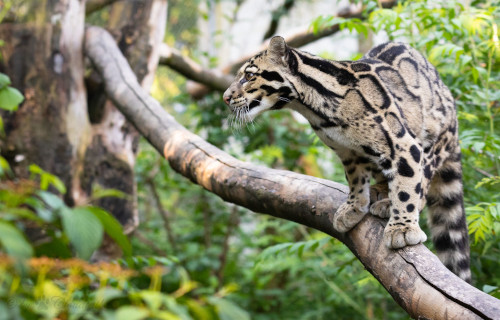
Photo: Cloudtail the Snow Leopard
CCL: https://tinyurl.com/462rnnjn
Clouded Leopard Physical Description
The gorgeous Clouded Leopard almost immediately captures the attention of all those who encounter it, as most wild felines do. Some, though, only do so due to their visual appeal. This mammal has more to offer, however, because it also boasts some quite respectable dimensions.
In that specific regard, though, the animal follows a pattern common to its many relatives. That’s in the fact that it displays a certain degree of the physiological characteristic of sexual dimorphism. In its specific case, this natural trait manifests itself purely in terms of overall physical size.
Slightly smaller in size, females of the species attain an average body length of approximately 27 – 37 in (68.6 – 94 cm). The tail also typically adds another 24 – 32 in (61 – 82 cm). Weights for this sex also remain less than the male. This usually ranges from roughly 22 – 30 lb (10 – 13.6 kg).
Males of this marvel, meanwhile, achieve moderately greater lengths and much more significant masses. For them a mean body length equals about 32 – 43 in (81 – 108 cm). Their tail adds an additional 29 – 36 in (74 – 91 cm). Masses for them, however, average 44 – 55 lb (20 – 25 kg).
Otherwise, both the genders of the awesome Clouded Leopard present the same outward appearance. Despite the notable length and weight differences, shoulder height for both averages 20 – 22 in (50 – 55 cm). The males thus have a significantly stockier build than the females.
The wild feline also has a distinctive pattern of coloring. The background consists of either an ocher or dark gray. Yet, muliple splotches of dark gray or black mark the coat without pattern, and of random sizes and shapes. These even appear on the face, while the ears show purely black.
- Kingdom: Animalia
- Phylum: Chordata
- Class: Mammalia
- Order: Carnivora
- Family: Felidae
- Genus: Neofelis
- Species: N. nebulosa
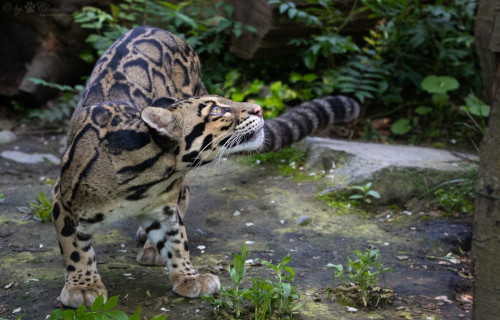
Clouded Leopard Distribution, Habitat, and Ecology
The breathtaking Clouded Leopard apparently evolved as native to a comparatively broad swathe of the surface of the globe. The full extent of that zone of habitation might come as a surprise to some of our readers, though. That’s because the amazing animal occupies a large portion of Asia.
Within that larger overall range, however, it doesn’t appear in every part of the continent. It mainly resides in the souteastern sections. From there, though, its natural territory also expands into China. Yet, in another direction, its range also reaches deep into the Himalayan foothills in Nepal.
Fortunately, this incredible creature has an extremely high level of flexibility regarding its choice of habitat type. It therefore appears in a wide range of local ecosystems. This flexibility extends to altitudes, since it also lives at heights ranging from near sea level to 12,200 ft (3,720 m).
In some parts of its territory, the mammal lives in regions composed of sub-tropical, semi-deciduous forests. But, in other areas it also makes its home in largely evergreen woodlands. In some regions, such as Thailand, the intrepid feline also lives in sections of dry tropical forest.
Like many of its kindred around the world, the stunning Clouded Leopard principally lives a solitary life. It’s also mainly nocturnal in nature, and even mostly arboreal in nature. The cat’s extremely reclusive, and thus rarely seen, except for being caught by the occasional camera trap video.
Being a feline, it’s also naturally entirely carnivorous in terms of diet. It’s surprisingly quite versatile, though. Somtimes it actively stalks its prey, yet at others it waits in ambush. It primarily consumes moderate-sized prey, including macaques, lorises, pangolins, and squirriels, among others.
Rusty-Spotted Cat
Rusty-Spotted Cat Facts
- Closing out this article about 5 Astounding Asian Wild Cats is the intriguing creation of evolution bearing the name of Rusty-Spotted Cat.
- The term we’ve chosen to employ expertly represents the wonder, and also perfectly serves as the common name for this beautiful wild feline. Yet, it does have at least one other general title that it’s known by. That’s the extremely similar name of Rusty-spotted wildcat.
- Within the halls of science, however, the animal’s perhaps much better known by its entirely technical designation. Unfortunately, like many such tags, that’s one that remains somewhat difficult for the layperson to pronounce. It holds the formal moniker Prionailurus rubiginosus.
- This marvel of Nature and evolution received that epithet following the efforts of Isidore Geoffroy Saint-Hilaire. That highly respected Frence zoologist accomplished the first formal recognition of it as a separate and distinct species. She achieved that noteworthy feat in 1831.
- However, at that time, the eminent researcher provided the stunning mammal with an entirely different tag than the one it holds currently. Subsequent to her original taxonomic work, other researchers later proposed alternate official honorifics, until the one it holds presently.
- Sadly, like many of the species of the world, the stunning Rusty-Spotted Cat now finds itself in peril. Its population numbers appear to be dwindling rapidly, for various reasons. As a result, the IUCN now lists the mammal as Near Threatened on its Red List of Threatened Species.
- For the moment, habit loss appears to be the primary factor behind its decline. This occurs mainly due to its native habit being destroyed as part of cultivation efforts by humans. It also, however, now faces the threat of ongoing climate change, like all other species on earth today.
Rusty-Spotted Cat Physical Description
The fabulous Rusty-Spotted Cat elegantly proves the principle that beauty comes in all shapes and sizes among the earth’s fauna. That’s because, by any measure, it’s a small species of feline, despite its great appeal. Nature continually demonstrates its apparent love of variety in its creations.
Following the evolutionary pattern common to many mammals, though, this amazing variety of feline displays the physiological characteristic of sexual dimorphism. It also follows the pattern of the majority of felines in that this trait primarily manifests itself in terms of sheer physical size.
More precisely, the males of the species attain a greater average body weight than the females. That difference, however, remains comparatively minor. A male reaches an average body weight of roughly 3.75 lb (1.7 kg.) The slightly smaller female, meanwhile, averages about 3.1 lb (1.4 kg).
In terms of overall appearance, though, the genders appear essentially indistinguishable to the casual observer. Typically, the fur develops as quite short, and mainly displays a brownish color across most of the body of the animal. It further shows a mild rusty tinge, hence the common name.
The animal does, though, present a different pattern on the throat and the underside of the body. There, the fur develops as a light white in color. It’s also marked with random dark stripes and spots. Typically, individuals also have four markedly dark stripes extending back from over the eyes.
- Kingdom: Animalia
- Phylum: Chordata
- Class: Mammalia
- Order: Carnivora
- Family: Felidae
- Genus: Prionailurus
- Species: P. rubiginosus
Rusty-Spotted Cat Distribution, Habitat, and Ecology
Lamentably, the Rusty-Spotted Cat only appears to inhabit a very small portion of the surface of the globe. In this instance, that region covers a tiny section of the continent of Asia. More specifically, the only known habitat range of the animal consists of portions of Sri Lanka and India.
Its main habitat qualifies as very specific in nature. The majority of individuals appear in regions of relatively dry forests. In recent years, however, small groups have begun to appear in agricultural areas inhabited by humans. The exact reason for this currently still remains unknown.
Yet, its impressive degree of adaptability does not end there. Perhaps in response to increasing human encroachment on its natural territory, groupings now appear to be expanding their zone of habitation. In fact, a few scattered individuals now even inhabit both tropical and semi-arid areas.
Evidence further indicates that the fascinating Rusty-Spotted Cat evolved as a mainly solitary animal. Most individuals live alone, and usually remain within clearly defined personal territories. Although mainly terrestrial in nature, it also displays tendencies toward arboreal activities.
Like its many related species around the world, this mammal also evolved as carnivorous in nature. Given its size, its prey typically consists of smaller creatures. This largely consists of small birds and other mammals. Yet it also feeds opportunistically, including eating insects such as crickets.
Somewhat surprisingly for researchers, this intrepid wonder appears to have no natural predators. It must be pointed out, however, that detailed studies of its habits and life cycle remain few, at least for the moment. Most likely, it falls prey to a variety of larger carnivores sharing its native range.
5 Astounding Asian Wild Cats
We hope that each of you greatly enjoyed reading, and hopefully learning from, this article we’ve compiled for you about these 5 Astounding Asian Wild Cats. It’s also our fervent hope that doing so has left each of you with either a new or renewed appreciation for such wonders of Nature.
Unfortunately, however, many of their numerous kindred located around the world now find themselves facing strong threats to their continued existence as a species. Many of those dangers, in fact, stem from the actions of mankind. We must do all we can to protect and preserve them all.
Check out our other articles on 3 Beautiful Butterflies of Canada, Earth’s Amazingly Abundant Avians, 4 Incredible African Insects, Spectacular Dolphins Throughout Our World
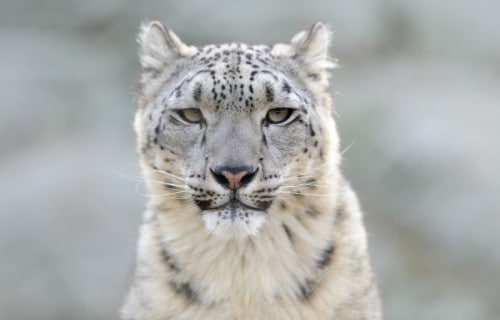
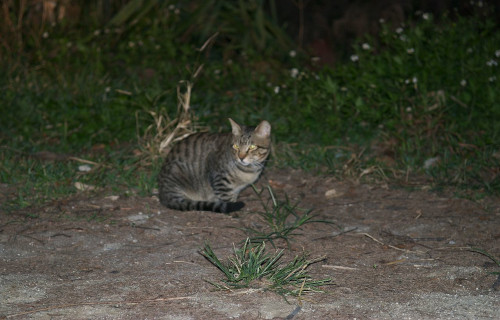
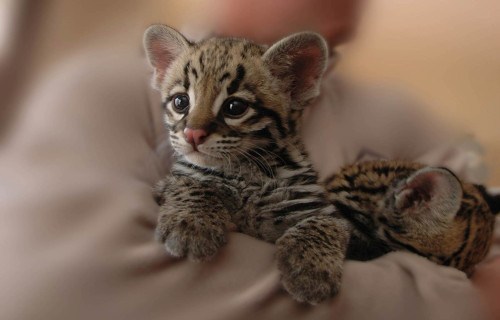
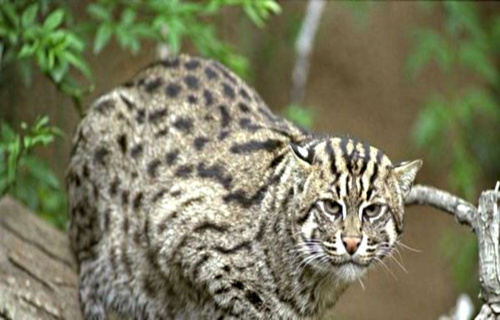
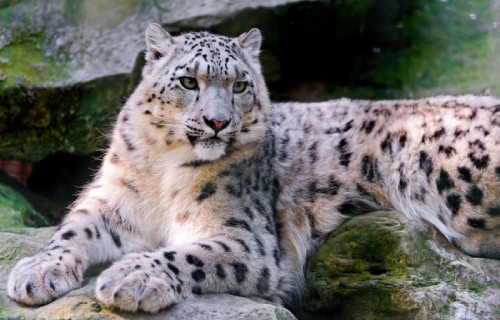
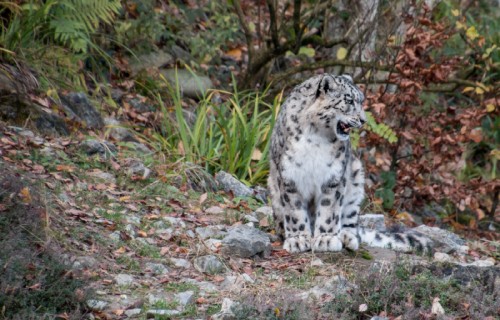

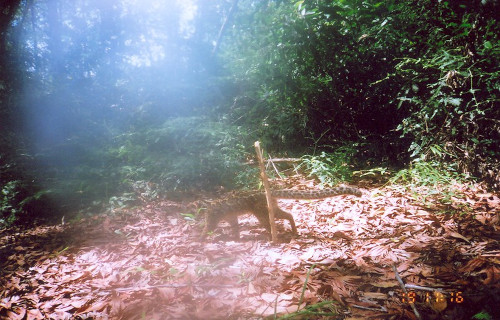
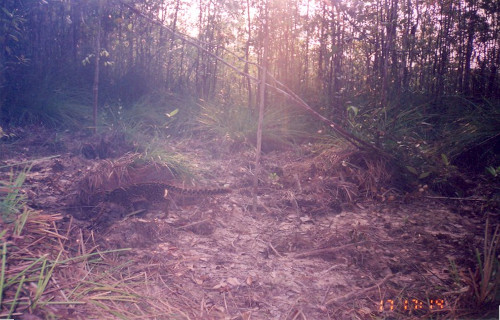
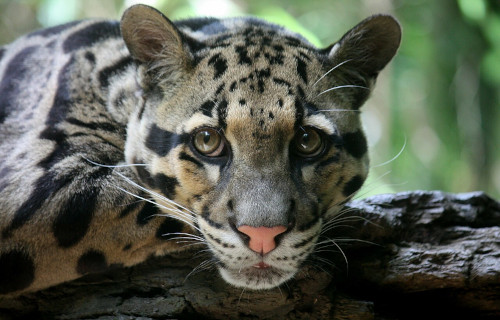
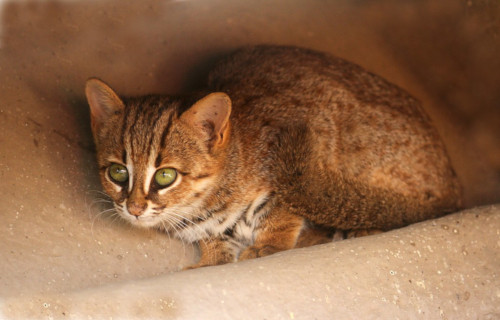
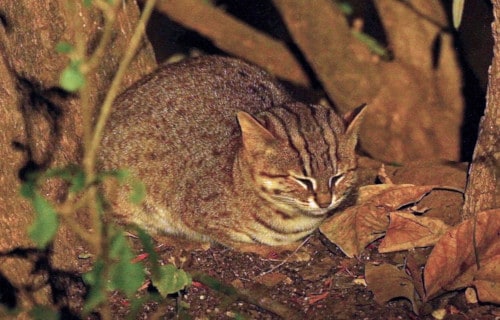
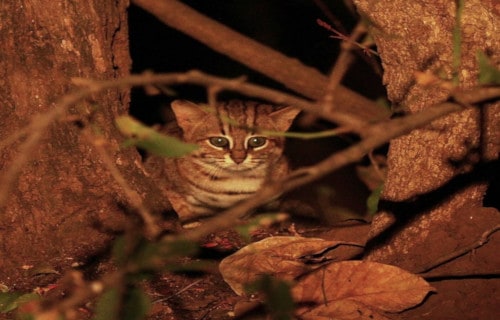









Leave a Reply